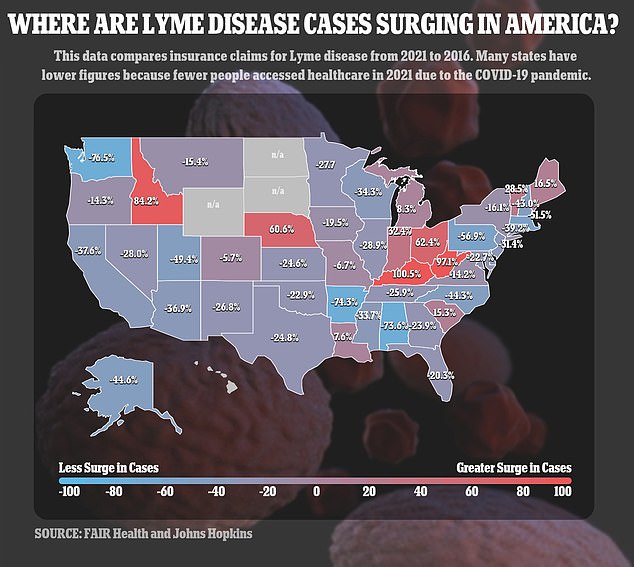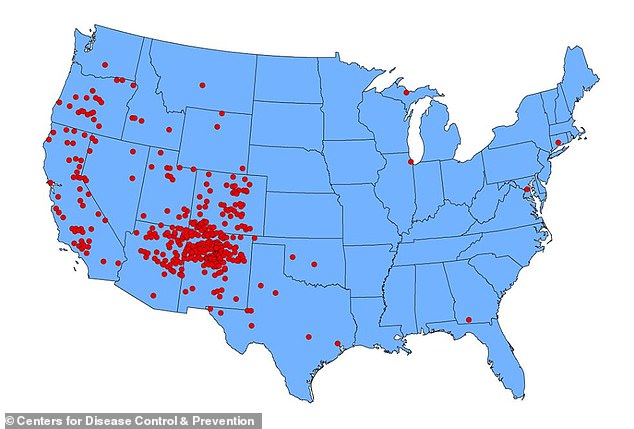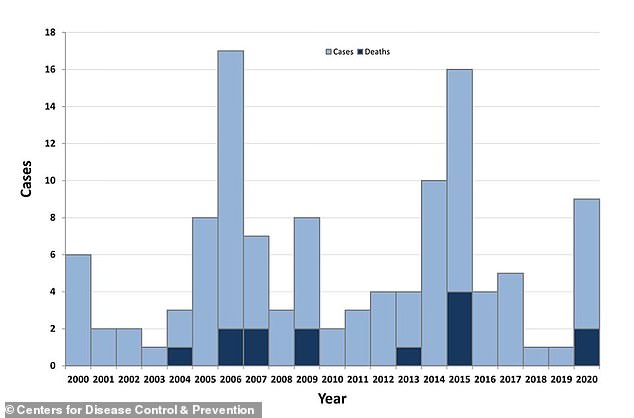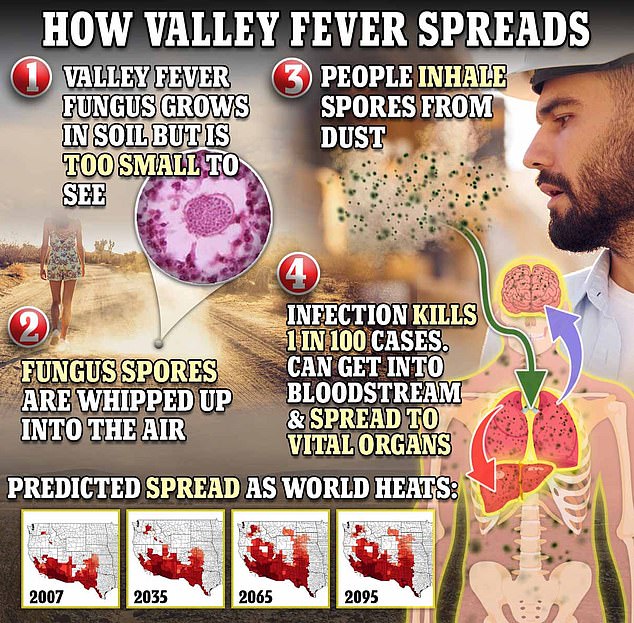Now experts warn that climate change could unleash a cascade of deadly viruses, fungi and flesh-eating bacteria – ‘causing absolute chaos for the world’
Climate change could lead to a surge of viruses and the resurgence of old diseases such as the plague, a US government-funded study suggests.
Researchers in California and Massachusetts warned that climate change could lead to an increase in infectious diseases caused by viruses, bacteria, fungi and parasites.
This includes tick-borne diseases such as malaria since the tick season starts several months earlier, as well as new fungal infections due to rising extreme temperatures.
And ancient diseases like the bubonic plague could become more common, which has already been seen in states like New Mexico.
The study, which was funded in part by grants from the NIH, urged doctors to maintain “a high index of suspicion for disease in motion” in order to treat patients early.
The researchers also warned that an influx of infectious diseases “could cause absolute chaos for the entire world.”
Researchers warned that climate change could lead to an influx of mosquito- and tick-borne diseases such as Lyme disease, Zika, dengue and malaria

The above map shows the percentage change in Lyme disease cases in 2021 compared to 2016, five years ago
Dr. George R Thompson, lead author of the study and an infectious disease specialist at the University of California – Davis, said: ‘Physicians must be ready to deal with the changes in the infectious disease landscape.’
‘Learning about the connection between climate change and illness behavior can help diagnose, treat and prevent infectious diseases.’
The authors sounded the alarm about vector-borne diseases, diseases that result from an infection transmitted by blood-feeding insects such as mosquitoes, ticks and fleas.
These include dengue, Zika and malaria, which are most common in developing countries and extremely rare in the US because winter temperatures wipe out the disease-carrying mosquitoes.
However, as winters become shorter and warmer, these mosquitoes have a greater chance of surviving and spreading disease.
In addition, changing rainfall patterns have brought them closer to the US and other developed countries.
The latest CDC data shows that there were more than 1,400 cases of dengue in the U.S. in 2019, an increase of nearly 170 percent compared to the annual number for the previous eight years.
And last year, five people in Florida were infected with malaria, marking the first time the disease has been seen in the US in two decades.
The authors also noted that, for example, tick-borne diseases such as Lyme disease now occur in winter and in areas further west and north than in the past.
Dr. Matthew Phillips, study author and infectious disease fellow at Massachusetts General Hospital, said, “We are seeing cases of tick-borne diseases in January and February.”
‘The tick season starts earlier and with more active ticks in a larger range. This means that the number of tick bites is increasing and thus also the tick-borne diseases.’

Experts warned that the increased number of cases of bubonic plague could be due to climate change. This map from the CDC shows that most cases of plague in the US since 1970 have occurred in the Four Corners area, which includes New Mexico, Utah, Arizona and Colorado.

The CDC estimates that seven cases of the plague are reported in the US each year
In 2022, data from FAIR Health and Johns Hopkins University showed that cases of Lyme disease rose most rapidly in Kentucky, West Virginia, Idaho, Ohio and Nebraska. Experts warned this was due to higher seasonal temperatures opening new habitats for ticks in mountainous areas. areas.
In the case of malaria, which tends to be most prevalent in tropical and subtropical areas of Africa, the experts said mosquitoes that carry the disease are spreading north due to changing rainfall patterns.
“As an infectious disease physician, locally acquired cases of malaria were one of the scariest things that happened last summer,” Dr. Phillips said.
“We saw cases in Texas and Florida and then all the way north in Maryland, which was really surprising. It happened to people who didn’t travel outside the US.”
In addition, the team drew attention to zoonotic diseases, which spread between humans and animals. Common examples include the bubonic plague and hantavirus, which are spread by rodents.
The team said these disease-carrying animals have lost their habitat due to climate change, bringing them closer to humans.
“This creates a greater risk that animal diseases will spread to humans and that new pathogens will arise,” the researchers wrote.
The bubonic plague, infamous for wiping out half of Europe’s population in the 13th century, has largely been extremely rare in the US.
According to the CDC, only seven cases are reported each year.
However, the disease could be showing signs of increasing as disease-carrying rodents move closer to humans and establish themselves in southwestern areas such as New Mexico and Arizona.
Earlier this month, a New Mexico man became the first in four years to die from the plague.

Nick Duggan contracted Valley Fever in 2010. Although he now lives a relatively normal life, he said it took him five years to recover

Devin Buckley, 24, was an average 18-year-old when he started experiencing fatigue, weight loss and shortness of breath. At one point he had to be put on a ventilator for two weeks. Mr Buckley told NBC News: ‘The ventilator was on at 100% at one point. It breathed for me. They said to my mother: prepare yourself that I am not here’

A month earlier, an Oregon resident fell ill with the disease after contracting it from his symptomatic cat.
Additionally, the team said the emergence of new fungal infections such as Candida auris (C. auris) and the increase in Valley Fever cases could be due to rising temperatures.
They noted that Valley Fever, for example, has been diagnosed as far north as Washington state, despite being most common in states with warm climates such as Arizona and California.
Last year, business owner Nick Duggan said he most likely contracted Valley Fever while biking in the San Diego desert in 2010 and inhaling mold spores from blowing dust.
By the time doctors figured out what it was, the infection had spread to his spine and brain and caused meningitis, leaving him bedridden for four months and in and out of the hospital for five years.
Although he now lives a relatively normal life, he said it took about five years to recover.
Additionally, Devin Buckley was 18 when he began experiencing fatigue, weight loss and shortness of breath.
Ultimately, he was diagnosed with Valley Fever in an intensive care unit in Chicago. Mr Buckley’s infection also spread to his spine and legs, and he had to be put on a ventilator three times.
The longest was two weeks. Mr Buckley told NBC News: ‘The ventilator was on at 100% at one point. It breathed for me. They told my mother: prepare yourself that I will not be here anymore.’
Mr Buckley is now out of hospital, but his life is no longer the same. Doctor’s appointments, surgeries and inpatient stays are on his calendar.
He also had to relearn daily tasks, including walking and eating.
The researchers in the new study also linked rising sea levels and extreme events such as flooding to water-borne diseases such as the spread of E coli.
The team warned doctors to increase surveillance of infectious diseases to stay ahead of the climate-related surge.
‘It’s not a hopeless situation. There are several steps we can take to prepare for and help manage these changes,” said Dr. Phillips.
‘Doctors see firsthand the impact of climate change on people’s health. As such, they play a role in advocating for policies that can slow climate change.”
The research was published on Wednesday in JAMA.
